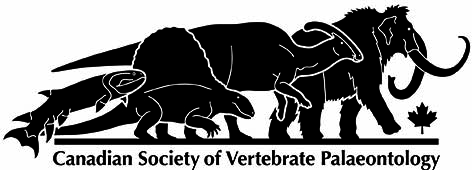A subadult individual of Styracosaurus albertensis (Ornithischia: Ceratopsidae) with comments on ontogeny and intraspecific variation in Styracosaurus and Centrosaurus.
DOI:
https://doi.org/10.18435/vamp29361Keywords:
Ceratopsidae, Dinosauria, Alberta, Growth, Ontogeny, Ornamentation, OrntihischiaAbstract
Styracosaurus albertensis is an iconic centrosaurine horned dinosaur from the Campanian of Alberta, Canada, known for its large spike-like parietal processes. Although described over 100 years ago, subsequent discoveries were rare the last few decades, during which time several new skulls, skeletons, and bonebeds were found. Here we described an immature individual, the smallest known for the species, represented by a complete skull and fragmentary skeleton. Although ~80% maximum size, it possesses a suite of characters associated with immaturity, and is regarded as a subadult. The ornamentation is characterized by a small, recurved, but fused nasal horncore; low, rounded postorbital horncores; and short, triangular, and flat parietal processes. Using this specimen, and additional skulls and bonebed material, the cranial ontogeny of Styracosaurus is described, and compared to Centrosaurus. Styracosaurus shows a similar early ontogeny of the nasal horncore, starting thin, recurved, and unfused, but retains the recurved morphology into large adult size, and never develops the procurved morphology common in Centrosaurus. The postorbital horncores of Styracosaurus are lower and more rounded than those of Centrosaurus throughout ontogeny, and show greater resorption later in ontogeney. The length and thickness of the parietal processes increase drastically through ontogeny, but their position and orientation are static across the size series. Several diagnostic Styracosaurus albertensis specimens now preserve medially orientated P3 spikes, causing issues for the diagnosis of S. ovatus. Variability in parietal ornamentation, either expression of P1 and P2 parietal processes, or other cranial ornamentations, does not appear to correlate with stratigraphy.
Downloads
References
Brown, C.M., Russell, A.P., and Ryan, M.J. 2009. Pattern and transition of surficial bone texture of the centrosaurine frill and their ontogenetic and taxonomic implications. Journal of Vertebrate Paleontology, 29: 132-141.
Currie, P.J., Holmes, R.B., Ryan, M.J., and Coy, C. 2016. A juvenile chasmosaurine ceratopsid (Dinosauria, Ornithischia) from the Dinosaur Park Formation, Alberta, Canada. Journal of Vertebrate Paleontology, 36: e1048348.
Dodson, P. 1989. Avaceratops lammersi: a new ceratopsid from the Judith River Formation of Montana. Proceedings of the Academy of Natural Sciences of Philadelphia, 138: 305-317.
Dodson, P., and Currie, P.J. 1988. The smallest ceratopsid skull - Judith River Formation of Alberta. Canadian Journal of Earth Science, 24: 926-930.
Evans, D.C. 2007. Ontogeny and evolution of lambeosaurine dinosaurs (Ornithischia: Hadrosauridae). In Department of Ecology and Evolutionary Biology. University of Toronto, Toronto, Canada. p. 497.
Evans, D.C. 2010. Cranial anatomy and systematics of Hypacrosaurus altispinus, and a comparative analysis of skull growth in lambeosaurine hadrosaurids (Dinosauria: Ornithischia). Zoological Journal of the Linnean Society, 159: 398-434.
Farke, A.A. 2010. Evolution, homology, and function of the supracranial sinuses in ceratopsian dinosaurs. Journal of Vertebrate Paleontology, 30: 1486-1500.
Frederickson, J.A., and Tumarkin-Deratzian, A.R. 2014. Craniofacial ontogeny in Centrosaurus apertus. PeerJ, 2: e252.
Gilmore, C.W. 1917. Brachyceratops, a ceratopsian dinosaur from the Two Medicine Formation of Montana, with notes on associated fossil reptiles. United States Geological Survey Professional paper, 103: 1-45.
Gilmore, C.W. 1922. The smallest known horned dinosaur, Brachyceratops. United States National Museum Proceedings, 61: 1-45.
Gilmore, C.W. 1930. On dinosaurian reptiles from the Two Medicine Formation of Montana. United States National Museum, Proceedings, 77: 1-39.
Godfrey, S.J., and Holmes, R. 1995. Cranial morphology and systematics of Chasmosaurus (Dinosauria: Ceratopsidae) from the Upper Cretaceous of western Canada. Journal of Vertebrate Paleontology, 15: 726-742.
Goodwin, M.B., Clemens, W.A., Horner, J.R., and Padian, K. 2006. The Smallest Known Triceratops Skull: New Observations on Ceratopsid Cranial Anatomy and Ontogeny. Journal of Vertebrate Paleontology, 26: 103-112.
Holmes, R., and Ryan, M. 2013. The postcranial skeleton of Styracosaurus albertensis. Kirtlandia, 58: 5-37.
Holmes, R.B., Persons, W.S.I., Rupal, B.S., Qureshi, A.J., and Currie, P.J. 2020. Morphological variation and asymmetrical development in the skull of Styracosaurus albertensis. Cretaceous Research, 107.
Lambe, L.M. 1913. A new genus and species of Ceratopsia from the Belly River Formation of Alberta. Ottawa Naturalist, 27: 109-116.
McDonald, A.T. 2011. A subadult specimen of Rubeosaurus ovatus (Dinosauria: Ceratopsidae), with observations on other ceratopsids from the Two Medicine Formation. PLoS ONE, 6: e22710.
Penkalski, P., and Dodson, P. 1999. The morphology and systematics of Avaceratops, a primitive horned dinosaur from the Judith River Formation (Late Campanian) of Montana, with the description of a second skull. Journal of Vertebrate Paleontology, 19: 692-711.
Ryan, M.J. 2007. A new basal centrosaurine ceratopsid from the Oldman Formation, Southeastern Alberta. Journal of Paleontology, 81: 376-396.
Ryan, M.J., Evans, D.C., and Shepherd, K.M. 2012. A new ceratopsid from the Foremost Formation (middle Campanian) of Alberta. Canadian Journal of Earth Sciences, 49: 1251-1262.
Ryan, M.J., Holmes, R., and Russell, A.P. 2007. A revision of the late Campanian centrosaurine ceratopsid genus Styracosaurus from the Western Interior of North America. Journal of Vertebrate Paleontology, 27: 944-962.
Sampson, S.D., Ryan, M.J., and Tanke, D.H. 1997. Craniofacial ontogeny in centrosaurine dinosaurs (Ornithischia: Ceratopsidae): taxonomic and behavioral implications. Zoological Journal of the Linnean Society, 121: 293-337.
Scannella, J.B., Fowler, D.W., Goodwin, M.B., and Horner, J.R. 2014. Evolutionary trends in Triceratops from the Hell Creek Formation, Montana. Proceedings of the National Academy of Sciences, 111: 10245-10250.
Sternberg, C.M. 1927. Horned dinosaur group in the National Museum of Canada. Canadian Field Naturalist, 41: 67-73.
Tokaryk, T.T. 1997. First evidence of juvenile ceratopsians (Reptilia: Ornithischia) from the Frenchman Formation (late Maastrichtian) of Saskatchewan. Canadian Journal of Earth Sciences, 34: 1401-1404.
Tumarkin-Deratzian, A.B. 2010. Histological evaluation of ontogenetic bone surface texture changes in the frill of Centrosaurus apertus. In New perspectives on horned dinosaurs, the Royal Tyrrell Museum Ceratopsian Symposium. Edited by M.J. Ryan and B.J. Chinnery-Algeier and D.A. Eberth. Indiana University Press, Bloomington. pp. 251-263.
Downloads
Published
How to Cite
Issue
Section
License
Copyright (c) 2020 Caleb Brown, Robert Holmes, Phillip Currie

This work is licensed under a Creative Commons Attribution 4.0 International License.
Submission of an article to Vertebrate Anatomy Morphology Palaeontology will be taken to mean that the article is an original work and not previously published or under consideration for publication elsewhere.
If the article is accepted for publication, it will be published on-line under Creative Commons Attribution 4.0 International (CC By 4.0) meaning:
Attribution — You must give appropriate credit, provide a link to the license, and indicate if changes were made. You may do so in any reasonable manner, but not in any way that suggests the licensor endorses you or your use.
No additional restrictions — You may not apply legal terms or technological measures that legally restrict others from doing anything the license permits.







